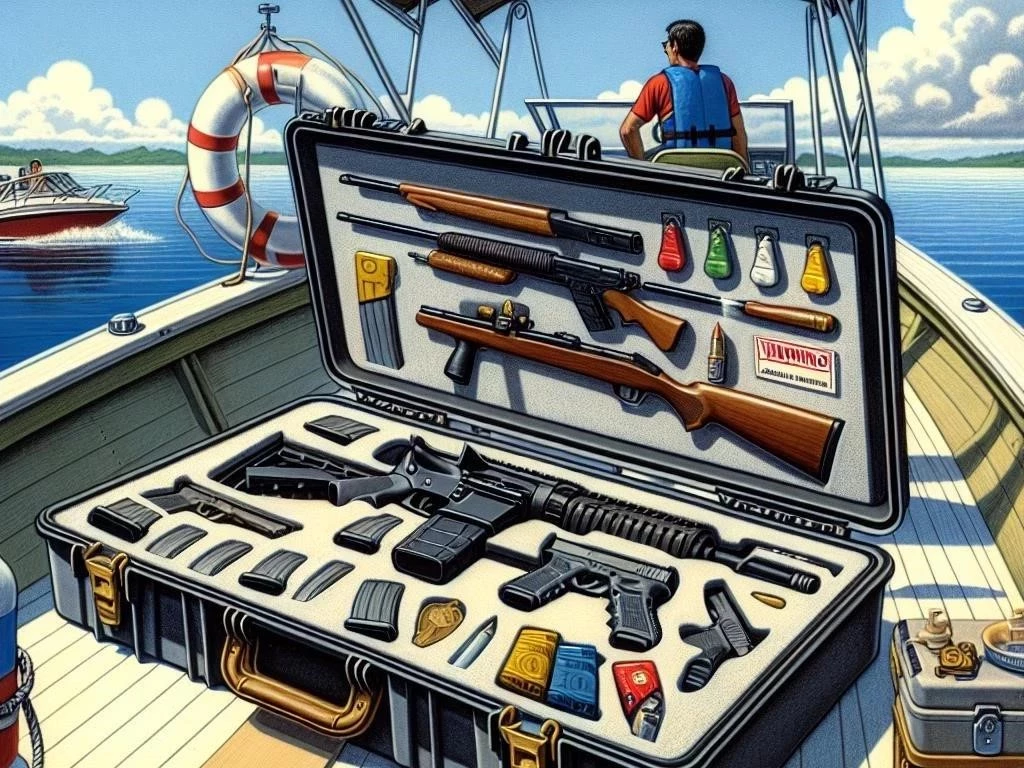How Should Firearms be Transported on a Boat?
Transporting firearms on a boat requires adherence to legal requirements, safe handling practices, and secure storage methods to ensure safety during outdoor activities․
Understanding Legal Requirements
When transporting firearms on a boat, it’s crucial to understand the local firearm laws and marine regulations that apply․ Each state may have specific legal requirements regarding the transportation of firearms on watercraft, including whether firearms must be unloaded or stored in a particular manner․ Familiarize yourself with regulations regarding firearm transportation, including any restrictions on carrying ammunition․ Always check the legalities before heading out to ensure compliance with firearm laws to avoid penalties․ Additionally, ensure that your boating gear includes all necessary documentation for firearm ownership․ Staying informed about these requirements is essential for responsible ownership and contributes to safer outdoor activities on your fishing boat or during hunting expeditions․
Safe Firearm Handling Practices
Practicing safe firearm handling is essential when transporting firearms on a boat․ Always treat every firearm as if it is loaded, ensuring the muzzle is pointed in a safe direction at all times․ Before boarding, ensure that firearms are unloaded, and any ammunition is stored separately in a secure location․ Handle firearms only when necessary and avoid distractions while doing so․ When on the boat, refrain from passing firearms around; instead, place them in designated secure storage․ Maintain awareness of your surroundings and ensure passengers understand firearm safety protocols․ Proper communication with fellow boaters about firearm presence can enhance safety and ensure responsible ownership during outdoor activities, such as fishing or hunting expeditions․
Secure Storage of Firearms on a Vessel
Secure storage of firearms on a vessel is crucial for safety during boating activities․ Firearms should be stored in a locked compartment or case, preventing unauthorized access and ensuring they remain secure during travel․ Use specialized gun storage containers that are waterproof and impact-resistant to protect your firearms from environmental elements․ Ensure that all firearms are unloaded before storage, and store ammunition in a separate, secure location to minimize risk․ Regularly check storage areas for any potential hazards and maintain an organized system to facilitate quick access if necessary․ By following these guidelines, you can ensure safe firearm storage while adhering to responsible ownership principles during your outdoor adventures on the water․
3․1 Firearm Storage Options
When it comes to firearm storage options on a boat, there are several effective methods to consider․ Firstly, using a locked hard case provides excellent protection against water and impact, ensuring your firearms remain secure․ Additionally, soft-sided cases with padding can be utilized for easier transport but may require extra care against moisture․ Another option is a dedicated gun locker installed within the vessel, designed specifically for secure storage․ Regardless of the option chosen, ensure that the storage location is easily accessible yet out of reach of unauthorized individuals, especially children․ Always check that cases are securely closed and locked before embarking․ Implementing these storage strategies contributes to safe firearm transportation during boating activities․
3․2 Ammunition Storage Guidelines
Proper ammunition storage is critical when transporting firearms on a boat․ Always store ammunition in a separate, secure container to prevent accidental discharge and unauthorized access․ Select waterproof and impact-resistant cases to protect ammunition from moisture and damage․ Clearly label ammunition containers to specify the type and caliber, ensuring easy identification․ Avoid storing ammunition in the same compartment as firearms to reduce risk․ Additionally, keep the storage area cool and dry, as extreme temperatures can affect ammunition performance․ Conduct regular checks on stored ammunition to ensure integrity and replace any compromised rounds․ Following these guidelines enhances safety protocols, ensuring responsible ownership while engaging in outdoor activities like fishing or hunting on the water․
Boating Safety Equipment for Firearm Transportation
When transporting firearms on a boat, having the right boating safety equipment is essential for ensuring a secure environment․ First, ensure that all required personal flotation devices (PFDs) are on board, as they are crucial for safety during emergencies; Additionally, equip your vessel with fire extinguishers, signaling devices, and first aid kits, as these items can aid in emergency preparedness․ Secure storage solutions for firearms, such as locked compartments, are vital to maintain safety․ It’s also wise to have an appropriate tool kit for any boat maintenance needs․ Investing in quality boating gear enhances overall vessel safety, allowing for responsible firearm handling while enjoying outdoor activities on the water, whether fishing or hunting․
4․1 Essential Boat Safety Gear
Having essential boat safety gear is critical when transporting firearms on a vessel․ First, ensure that personal flotation devices (PFDs) are available for all passengers, as they are vital for safety․ Additionally, keep a fire extinguisher on board to address any potential fire hazards․ A comprehensive first aid kit is necessary for treating injuries that may occur during outdoor activities․ Flares or signaling devices should also be included to communicate distress in emergencies․ Furthermore, consider having a working marine radio for reliable communication․ All equipment should be easily accessible and inspected regularly to ensure functionality․ By maintaining this essential safety gear, you enhance overall safety while responsibly managing firearms during boating activities․
4․2 Importance of Vessel Safety
Vessel safety is paramount when transporting firearms, as it directly affects the wellbeing of all passengers and equipment on board․ A well-maintained and safe vessel minimizes the risk of accidents, ensuring that firearms are securely stored and handled․ Conduct regular inspections to identify potential hazards, such as leaks or structural issues, that could jeopardize safety․ Proper weight distribution and adherence to loading capacities are essential for maintaining stability and preventing capsizing․ Additionally, being aware of environmental conditions, such as weather changes, enhances overall safety․ Implementing vessel safety protocols contributes to responsible ownership and ensures that all outdoor activities, including fishing and hunting, can be conducted without unnecessary risks on the water․
Marine Regulations Regarding Firearms
Understanding marine regulations regarding firearms is essential for safe and legal transportation on a boat․ Various jurisdictions may have specific laws governing the carrying and storage of firearms while on water․ It’s crucial to know whether firearms must be unloaded and how they should be stored during transit․ Some regions may require firearms to be locked in a secure container, while others might have different guidelines․ Additionally, familiarize yourself with any restrictions on transporting certain types of firearms or ammunition․ Always consult local laws and regulations before embarking on your journey to avoid legal issues․ Adhering to these regulations promotes responsible ownership and ensures the safety of everyone involved during outdoor activities․
Emergency Preparedness While Boating
Emergency preparedness is vital when transporting firearms on a boat, ensuring safety during unexpected situations․ First, create a comprehensive emergency plan that includes potential scenarios such as capsizing, medical emergencies, or firearm-related incidents; Ensure that all passengers are familiar with this plan and know their roles in case of an emergency․ Equip your vessel with essential safety equipment, including life jackets, first aid kits, and signaling devices․ Regularly conduct safety drills to practice responses to emergencies, ensuring everyone understands how to react quickly and effectively․ Additionally, maintain open communication with others on the water, and always carry a marine radio for immediate access to assistance․ Preparedness fosters responsible ownership and enhances safety during outdoor activities․
Responsible Ownership and Outdoor Activities
Responsible ownership is crucial when transporting firearms during outdoor activities, such as fishing and hunting․ Always prioritize safety by ensuring firearms are securely stored and handled appropriately at all times․ Educate yourself and others on firearm laws and safe practices, fostering a culture of responsibility․ When aboard a boat, maintain awareness of your surroundings and ensure that all passengers understand safety protocols related to firearms․ Avoid consuming alcohol or engaging in risky behaviors while handling firearms․ Regular training on firearm handling and safety enhances skills and confidence․ By embodying responsible ownership, you contribute to a safer environment for everyone involved, ensuring enjoyable outdoor experiences while minimizing risks associated with firearm transportation on the water․
Boat Maintenance and Watercraft Security
Proper boat maintenance and watercraft security are essential when transporting firearms to ensure safety and functionality․ Regularly inspect your vessel for any mechanical issues, such as engine problems or leaks, that could compromise safety on the water․ Maintain all safety equipment, including life jackets and fire extinguishers, ensuring they are in good working order․ Additionally, secure firearms in locked compartments to prevent unauthorized access and theft․ Implementing effective watercraft security measures, such as using boat locks or alarms, enhances protection against potential theft․ Always remove firearms and valuable equipment when leaving the boat unattended․ By prioritizing maintenance and security, you ensure a safe and enjoyable experience while responsibly managing firearms during outdoor activities․














Post Comment